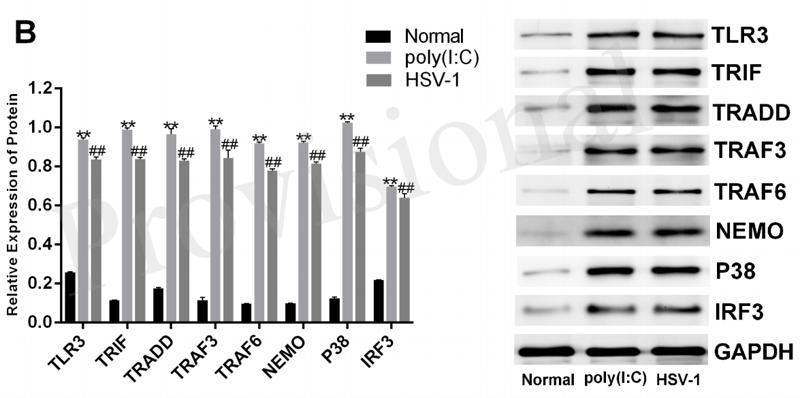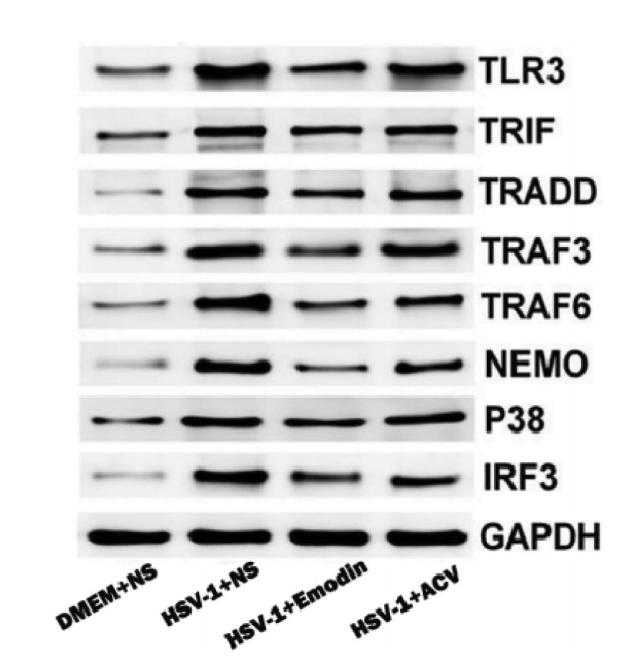TRADD Antibody - #DF6279
| Product: | TRADD Antibody |
| Catalog: | DF6279 |
| Description: | Rabbit polyclonal antibody to TRADD |
| Application: | WB IHC IF/ICC |
| Reactivity: | Human, Mouse, Rat |
| Prediction: | Pig, Bovine, Sheep |
| Mol.Wt.: | 34kDa; 34kD(Calculated). |
| Uniprot: | Q15628 |
| RRID: | AB_2838245 |
Related Downloads
Protocols
Product Info
*The optimal dilutions should be determined by the end user.
*Tips:
WB: For western blot detection of denatured protein samples. IHC: For immunohistochemical detection of paraffin sections (IHC-p) or frozen sections (IHC-f) of tissue samples. IF/ICC: For immunofluorescence detection of cell samples. ELISA(peptide): For ELISA detection of antigenic peptide.
Cite Format: Affinity Biosciences Cat# DF6279, RRID:AB_2838245.
Fold/Unfold
9130005N23Rik; AA930854; TNFR1 associated DEATH domain protein; TNFR1-associated DEATH domain protein; TNFRSF1A associated via death domain; TNFRSF1A-associated via death domain; tradd; TRADD_HUMAN; Tumor necrosis factor receptor type 1 associated DEATH domain protein; Tumor necrosis factor receptor type 1-associated DEATH domain protein;
Immunogens
- Q15628 TRADD_HUMAN:
- Protein BLAST With
- NCBI/
- ExPASy/
- Uniprot
MAAGQNGHEEWVGSAYLFVESSLDKVVLSDAYAHPQQKVAVYRALQAALAESGGSPDVLQMLKIHRSDPQLIVQLRFCGRQPCGRFLRAYREGALRAALQRSLAAALAQHSVPLQLELRAGAERLDALLADEERCLSCILAQQPDRLRDEELAELEDALRNLKCGSGARGGDGEVASAPLQPPVPSLSEVKPPPPPPPAQTFLFQGQPVVNRPLSLKDQQTFARSVGLKWRKVGRSLQRGCRALRDPALDSLAYEYEREGLYEQAFQLLRRFVQAEGRRATLQRLVEALEENELTSLAEDLLGLTDPNGGLA
Predictions
Score>80(red) has high confidence and is suggested to be used for WB detection. *The prediction model is mainly based on the alignment of immunogen sequences, the results are for reference only, not as the basis of quality assurance.
High(score>80) Medium(80>score>50) Low(score<50) No confidence
PTMs - Q15628 As Substrate
| Site | PTM Type | Enzyme | Source |
|---|---|---|---|
| K38 | Ubiquitination | Uniprot | |
| Y42 | Phosphorylation | Uniprot | |
| K163 | Ubiquitination | Uniprot | |
| S215 | Phosphorylation | Uniprot | |
| K229 | Ubiquitination | Uniprot | |
| S296 | Phosphorylation | Uniprot |
Research Backgrounds
The nuclear form acts as a tumor suppressor by preventing ubiquitination and degradation of isoform p19ARF/ARF of CDKN2A by TRIP12: acts by interacting with TRIP12, leading to disrupt interaction between TRIP12 and isoform p19ARF/ARF of CDKN2A (By similarity). Adapter molecule for TNFRSF1A/TNFR1 that specifically associates with the cytoplasmic domain of activated TNFRSF1A/TNFR1 mediating its interaction with FADD. Overexpression of TRADD leads to two major TNF-induced responses, apoptosis and activation of NF-kappa-B.
Nucleus. Cytoplasm. Cytoplasm>Cytoskeleton.
Note: Shuttles between the cytoplasm and the nucleus.
Found in all examined tissues.
Stimulation of TNF-alpha receptor TNFRSF1A leads to the formation of two distinct signaling complexes. Plasma membrane-bound complex I is composed of TNFRSF1A, TRADD, RIPK1, TRAF2 and BIRC2/c-IAP1 or BIRC3 which interacts with CHUCK/IKK-alpha, IKBKB/IKK-beta and IKBKG/IKK-gamma promoting cell survival. Subsequently, TRADD, RIPK1 and TRAF2 dissociate from TNFRSF1A and form cytoplasmic complex II with FADD and caspase CASP8 promoting cell apoptosis. Within complex I, interacts with TNFRSF1A/TNFR1, TRAF2 and kinase RIPK1. Within complex I, interacts with TRPC4AP; the interaction promotes NF-kappa B activation. UXT1 associates with complex I; the interaction prevents the formation of complex II. Within complex I Interacts with scaffold protein DAB2IP. Interacts with autophagy receptor SQSTM1. Interacts with E3 ligase TRIP12 (By similarity). Interacts with kinase HIPK2. Interacts with keratin KRT14. Interacts with keratin KRT18. Interacts with keratins KRT16 and KRT17 (By similarity). Interacts with FADD (By similarity).
Requires the intact death domain to associate with TNFRSF1A/TNFR1.
Research Fields
· Cellular Processes > Cell growth and death > Apoptosis. (View pathway)
· Cellular Processes > Cell growth and death > Necroptosis. (View pathway)
· Environmental Information Processing > Signal transduction > MAPK signaling pathway. (View pathway)
· Environmental Information Processing > Signal transduction > NF-kappa B signaling pathway. (View pathway)
· Environmental Information Processing > Signal transduction > Sphingolipid signaling pathway. (View pathway)
· Environmental Information Processing > Signal transduction > TNF signaling pathway. (View pathway)
· Human Diseases > Infectious diseases: Bacterial > Tuberculosis.
· Human Diseases > Infectious diseases: Viral > Hepatitis C.
· Human Diseases > Infectious diseases: Viral > Human papillomavirus infection.
· Human Diseases > Infectious diseases: Viral > Epstein-Barr virus infection.
· Human Diseases > Cancers: Overview > Viral carcinogenesis.
· Organismal Systems > Immune system > RIG-I-like receptor signaling pathway. (View pathway)
· Organismal Systems > Immune system > IL-17 signaling pathway. (View pathway)
· Organismal Systems > Endocrine system > Adipocytokine signaling pathway.
References
Application: WB Species: mouse Sample: BV-2 cells
Application: WB Species: Mice Sample: brain tissues
Restrictive clause
Affinity Biosciences tests all products strictly. Citations are provided as a resource for additional applications that have not been validated by Affinity Biosciences. Please choose the appropriate format for each application and consult Materials and Methods sections for additional details about the use of any product in these publications.
For Research Use Only.
Not for use in diagnostic or therapeutic procedures. Not for resale. Not for distribution without written consent. Affinity Biosciences will not be held responsible for patent infringement or other violations that may occur with the use of our products. Affinity Biosciences, Affinity Biosciences Logo and all other trademarks are the property of Affinity Biosciences LTD.


